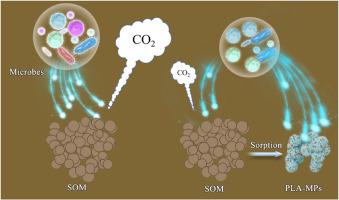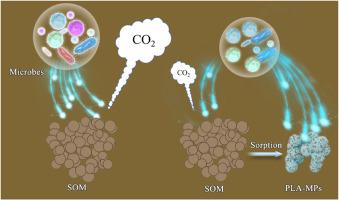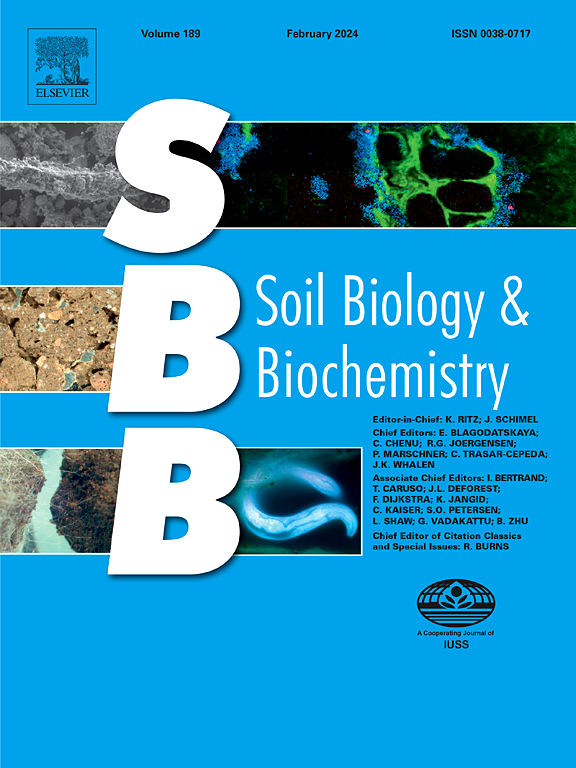Polylactic acid microplastics induced negative priming and improved carbon sequestration via microbial processes in different paddy soils
IF 9.8
1区 农林科学
Q1 SOIL SCIENCE
引用次数: 0
Abstract
Biodegradable microplastics (MPs), which are starting to be used in large quantities in croplands, may affect the mineralization of soil organic carbon (SOC). These priming effects induced by biodegradable MPs are a very new issue, and their mechanisms as well as consequences for various soils are nearly unknown. Using stable carbon isotope signature (δ13C), we quantified the priming effects by adding corn (C4 plant) -based polylactic acid (PLA, δ13C = 11.9‰) MPs to three paddy soils with solely C3 signature: Ferralsol, Alfisol and Mollisol at two rates (0.5 and 1.0 wt%, based on the mass of MPs). After the incubation (180 days), PLA-MPs reduced the SOC mineralization in all three soils, triggering a negative priming effect. This negative priming effect was strongest in Mollisol (210-220 mg CO2-C kg-1). The net C balance in Mollisol was positive and clearly higher than the C amounts initially added with PLA-MPs to soils, indicating C accrual. The two main mechanisms of the negative priming effects were: i) sorptive protection of SOC and especially dissolved organic carbon (DOC) by PLA-MPs, and ii) reduction of microbial biomass and fungal diversity after PLA-MPs addition. Additionally, “switching of microbial decomposition from SOC to PLA-MPs” was pronounced in Mollisol, indicated by more PLA-MPs being mineralized. PLA-MPs thus changed the soil C dynamics mediated in part by the changes of microbial biomass, diversity, and community composition, utilization switch to new resources and decrease of SOC mineralization, all of them leading to C accumulation in soil.


聚乳酸微塑料在不同稻田土壤中通过微生物过程诱导负引力并提高固碳效果
开始在农田中大量使用的可生物降解的微塑料(MPs)可能会影响土壤有机碳(SOC)的矿化。可生物降解的微塑料所引起的这些启动效应是一个非常新的问题,其机制以及对各种土壤造成的后果几乎无人知晓。利用稳定碳同位素特征(δ13C),我们量化了在三种仅具有 C3 特征的水稻土中添加玉米(C4 植物)基聚乳酸(PLA,δ13C = 11.9‰)多孔质材料所产生的启动效应:Ferralsol、Alfisol 和 Mollisol 三种水稻土中,MPs 的比例分别为 0.5% 和 1.0%。培养(180 天)后,聚乳酸-MPs 降低了所有三种土壤中的 SOC 矿化度,引发了一种负引导效应。这种负引导效应在 Mollisol 中最强(210-220 毫克 CO2-C kg-1)。在 Mollisol 中,净 C 平衡为正值,明显高于最初添加到土壤中的 PLA-MPs 的 C 量,这表明 C 累积。产生负引导效应的两个主要机制是:i)聚乳酸-MPs 对 SOC(特别是溶解有机碳)的吸附保护作用;ii)添加聚乳酸-MPs 后微生物生物量和真菌多样性的减少。此外,"微生物分解从 SOC 到 PLA-MPs 的转换 "在 Mollisol 中非常明显,这表现在更多的 PLA-MPs 被矿化。因此,PLA-MPs 改变了土壤中的碳动态,部分原因是微生物生物量、多样性和群落组成的变化、对新资源的利用转换以及 SOC 矿化的减少,所有这些都导致了土壤中的碳积累。
本文章由计算机程序翻译,如有差异,请以英文原文为准。
求助全文
约1分钟内获得全文
求助全文
来源期刊

Soil Biology & Biochemistry
农林科学-土壤科学
CiteScore
16.90
自引率
9.30%
发文量
312
审稿时长
49 days
期刊介绍:
Soil Biology & Biochemistry publishes original research articles of international significance focusing on biological processes in soil and their applications to soil and environmental quality. Major topics include the ecology and biochemical processes of soil organisms, their effects on the environment, and interactions with plants. The journal also welcomes state-of-the-art reviews and discussions on contemporary research in soil biology and biochemistry.
 求助内容:
求助内容: 应助结果提醒方式:
应助结果提醒方式:


